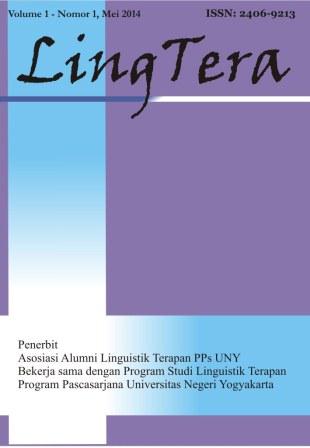A corpus-based analysis of discourse marker 'like' functions in podcasts: A gender study
DOI:
https://doi.org/10.21831/lt.v10i2.61245Keywords:
American Spotify podcasts, corpus, dyadic communication, discourse markers, discourse markers like functions.Abstract
Focusing on the use of discourse markers (DM), this study investigated the use of DM like in dyadic communication in American Spotify podcasts. This research aimed to understand the linguistic behavior of podcasters in using DM like during their podcasts and to compare the spoken corpus of female and male speakers collected from the podcast. Corpus analysis assisted by AntConc 3.5.9. was applied to determine (1) which gender primarily used DM like within the corpus, (2) the significance between the usage of DM like and the speaker's gender, and (3) the functions of using DM like by each gender based on Mí¼ller's (2005) taxonomy of DM like functions. The analysis portrayed that male speakers prefer to use DM like more than female podcast speakers, which is in contrast to previous studies claiming that female speakers used more DM like than male speakers. The difference in results could be attributed to the 17-year gap in the study, which has potentially led to changes in the inclination of using DM like between genders. However, despite male speakers' higher usage of DM like, there is still no correlation between the use of DM like and the speaker's gender, aligning with previous research. Lastly, this study revealed that both genders used the same DM like functions, although the occurrences varied.
References
Aijmer, K. (2022). "˜Did you just basically steal everything?' – A study of discourse -pragmatic variation and change. Journal of Pragmatics, 200, 8–23. https://doi.org/10.1016/j.pragma.2022.07.003
Andersen, G. (2001). Pragmatic markers and sociolinguistic variation: A relevance-theoretic approach to the language of adolescents. John Benjamins Publishing Company.
Biber, D., Conrad, S., & Reppen, R. (1998). Norming frequency counts. In Corpus Linguistics: Investigating Language Structure and Use (Cambridge Approaches to Linguistics, pp. 263-264). Cambridge University Press. doi:10.1017/CBO9780511804489.017.
Cahyanti. R. (2021). Discourse markers In A vlog video by bnay youtube channel. Language Horizon: Journal of Language Studies, 9(2). Retrieved from https://ejournal.unesa.ac.id/index.php/language-horizon/article/download/42512/36548/
Clifton, A., Pappu, A., Reddy, S., Yu, Y., Karlgren, J., Carterette, B., & Jones, R. (2020). The Spotify Podcasts Dataset. https://pypi.org/project/langid/
Crible, L., & Cuenca, M.-J. (2017). Discourse markers in speech: Distinctive features and corpus annotation. Dialogue & Discourse, 8(2), 149–166. https://doi.org/10.5087/dad.2017.207
Dardjowidjojo, S. (2014). Psikolinguistik: Pengantar pemahaman bahasa manusia (Kedua). Yayasan Pustaka Obor Indonesia.
Dohen, M., Schwartz, J.-L., & Bailly, G. (2010). Speech and face-to-face communication-An introduction. Speech Communication, 6, 477–480. https://doi.org/10.1016/j.specom.2010.02.016í¯.
Drager, K. K. (2011). Sociophonetic variation and the lemma. Journal of Phonetics, 39(4), 694–707. https://doi.org/10.1016/j.wocn.2011.08.005.
Fung, L., & Carter, R. (2007). Discourse markers and spoken English: Native and learner use in pedagogic settings. Applied Linguistics, 28(3), 410–439. https://doi.org/10.1093/applin/amm030
Gabrys, M. (2017). Like as a discourse marker in different varieties of English. Retrieved from https://dial.uclouvain.be/memoire/ucl/fr/object/thesis%3A11925/datastream/PDF_01/view.
Gaither, S. E., Cohen-Goldberg, A. M., Gidney, C. L., & Maddox, K. B. (2015). Sounding black or white: Priming identity and biracial speech. Frontiers in Psychology. https://doi.org/10.3389/fpsyg.2015.00457.
Kearney, M. (2017). Cramér's V. Retrieved from https://www.researchgate.net/publication/307963787_Cramer's_V.
Lakoff, R. (1975). Language and woman's place. Cambridge University Press.
Li, H. (2014). Small spoken corpus and oral English classroom. (ICSSR 2014). Retrieved from https://www.atlantis-press.com/article/11840.pdf.
Laserna, C. M., Seih, Y.-T., & Pennebaker, J. W. (2014). Um . . . Who Like Says You Know. Journal of Language and Social Psychology, 33(3), 328–338. https://doi.org/10.1177/0261927X14526993
Martín-Laguna, S., & Alcón-Soler, E. (2018). Development of discourse-pragmatic markers in a multilingual classroom: A mixed method research approach. System, 75, 68–80. https://doi.org/10.1016/j.system.2018.03.009
Mí¼ller, S. (2005). Discourse marker in native and non-native English discourse. John Benjamins Publishing Company.
Nurmukhamedov, U., & Sharakhimov, S. (2021). Corpus-Based vocabulary analysis of English podcasts. RELC Journal. https://doi.org/10.1177/0033688220979315.
Pasaribu, T.A. (2017). Male and female students' Use of textual discourse markers in writing academic essays. Journal of Language and Literature. Retrieved from https://e-journal.usd.ac.id/index.php/JOLL/article/view/587.
Pratiwi, L. R, Basthomi, Y., Yannuar, N., Hidayati, M., & Fuad Choiron, N. (2020). "You Know" Aa a disourse marker in English learners' spoken discourse: UM-speaks. In PJAEE, 17(7), Retrieved from https://archives.palarch.nl/index.php/jae/article/view/3096.
Ratih, E., & Abidah, K. H. (2022). The use of English discourse markers across gender: A corpus-based study. LingTera, 9(1), 53-62. https://doi.org/10.21831/lt.v9i1.52970.
Rundblad, G. (2015). Normalisation in Discourse Analysis. Retrieved from www.appliedlinguistics.org.uk.
Schiffrin, D. (1987). Discourse markers. Cambridge University Press. https://doi.org/10.1017/CBO9780511611841.
Schourup, L. C. (1983). Common discourse particles in English conversation. Working Papers in Linguistics, 28, 1-119. Retreived from https://core.ac.uk/download/pdf/159566699.pdf.
Taguchi, N. (2002). A comparative analysis of discourse markers in English conversational registers. Issues in Applied Linguistics, 13(1). https://doi.org/10.5070/l4131005052.
Tipton, E. (2014). Stratified sampling using cluster analysis: A sample selection strategy for improved generalizations from experiments. Evaluation Review, 37(2), 109–139. https://doi.org/10.1177/0193841X13516324.
Tolliver, D. (2012). Like and African American English: Factors and implications of language shift. Yale University Linguistic Department, USA. Retrieved from https://ling.yale.edu/sites/default/files/files/alumni%20senior%20essays/TolliverSeniorEssay.pdf.
Turhaan, N.S. (2020). Karl Pearson's chi-square tests. Academic Journals Vol. 15(9), pp. 575-580. DOI: 10.5897/ERR2019.3817.
Wardhaugh, R. & Fuller, Janet M. (2015). An Introduction to sociolinguistic (Seventh Edition). John Wiley & Sons, Inc.
Downloads
Published
How to Cite
Issue
Section
Citation Check
License
LingTera allows readers to read, download, copy, distribute, print, search, or link to its articles' full texts and allows readers to use them for any other lawful purpose. The journal allows the author(s) to hold the copyright without restrictions. Finally, the journal allows the author(s) to retain publishing rights without restrictions.
- Authors are allowed to archive their submitted articles in an open-access repository.
- Authors are allowed to archive the final published article in an open-access repository with an acknowledgment of its initial publication in this journal.

Psychology, Evaluation, and Technology in Educational Research is licensed under a Creative Commons Attribution-ShareAlike 4.0 International License.
Based on a work at https://petier.org/index.php/PETIER.









